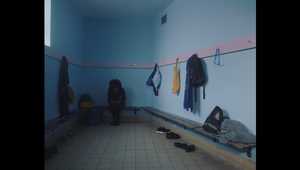
Making the Grade: Steffan Perry on the Subjectivity of Colour

Highly-regarded colorist Steffan Perry joined Company 3 after a very successful 24 year run at Framestore. He started at Framestore coloring dailies for an eclectic collection of TV work and soon moving into final color for commercial and music video work. He has brought his artistic eye to a great many spots for major international brands including Mercedes Benz, Renault, Adidas, Panasonic and Nike to name just a few.
Originally from North London, Perry began his career by studying advertising in Southampton, initially hoping to find an outlet for his creative energies on the agency side. He joined the respected postproduction company Dean Street Post in an entry-level position, hoping to make connections with ad agency executives, but quickly realized the incredible power of color grading. He moved into a color assist position there and then became a colorist in his own right. He later went to work at Framestore and became one of London’s most sought-after colorists.
LBB> What was your first experience with the world of colour grading – and when did you decide that being a colourist was a role that you wanted to pursue?
Steffan> After a month or so as a runner at Dean Street Post, I was opening up the building at 5am to receive rushes from Soho Images or Metro Colour and dropping them off into a large dark mysterious room that smelt of cigarettes. There was an adjoining room with machines with big reels that film and mag went on a bench with splicers and light boxes and small magnifying glasses. The smells and sounds were totally unique. I got my chance to assist and learn a craft that I didn’t know existed only months before. I had originally wanted to be a creative, then found Avid which blew my mind. After a few years I got my opportunity to join Framestore in 1997. The quality of work and clients went through the roof. The excitement and fulfilment of working with such talented people, albeit in a dark room, was way more than I had expected.
LBB> What was the project that you felt really changed your career?
Steffan> It was a Middle Eastern Pepsi commercial around 1995. The Telecine assistant at the time laced up the neg all wrong from being tail out and spun it back scratching all the film right down the middle. At this point he decided Colour (TK back then) wasn’t really for him, so he went off and decided to become a brilliant editor and own his own editing company. That left a space to be filled. Luckiest break ever!
LBB> How/where did you hone your craft and did you have any particular mentors?
Steffan> My original mentors when I first started grading were Max Horton and Christine Trodd, and since then I consider every grader I have worked alongside to be a mentor in one way or another.
Once I have a grade approved, time depending, I will try to match it in a simplified manner. This gives invariably a cleaner result, and with less baselight operators / layers being used, will be easier to manage and match.
Usually time doesn’t allow further investigating, but I will find myself going back to projects I have delivered and try different operators to get to the same grade. I can learn new ways to approach a grade this way, I’m never complacent and my grading style is constantly evolving.
LBB> Tell us more about your creative process - (e.g.when you get a project, how do you go about developing a look?)
Steffan> When working on a shortform project the key for me is to understand the narrative, timeline and characters as much as possible. Seeing script and pitch development is not always possible, however it’s important to grab as much information as possible before you start. Offline cuts will sometimes have clues, for example a grade on top of the transcodes may indicate a moment that has struggled to get through approval.
I’ll always check back to onset lut used as it’s a great guide to where the changes are occurring, log images are not to be considered when assessing what is happening in the colour correction, it’s a disservice to a DoP.
Going back to Rec is a cleanser, enabling to see with fresher eyes what’s happening in the grade. What you have just seen effects what you are about to see. If you keep looking at a tinted grade it will eventually be processed in your brain and can effectively be white balanced. Once I’m happy with a grade, I'll usually push it again; cross the line then come back.
LBB> From experience, we’ve found that colourists often love art and photography - when you’re out of the studio, what inspires you?
Steffan> The world around me. “Grubby” fluorescent lights, sunrises, a strong full moon illuminating the world, the deep green of golf course fairways, the vividness of Caribbean waters. I obviously love photography capturing natural moments in time like Martin Parr, to the staged cinematic glory of Gregory Crewdson. Todd Hido and my wonderful friend David Harriman, capturing absolute beauty in the sometimes mundane. I recently watched Cecil B DeMille’s 10 Commandments (1956) shot in Technicolor. Just so beautiful, so rich, sumptuous. The imperfections, of which there aren’t too many, are perfect in my eyes, I literally want to jump into the suite there and then and attempt to bring these aesthetics into a commercial.
LBB> Colour grading is largely a digital affair, but there’s also been a resurgence of film over the past few years in commercials and music videos. What are your thoughts about working on film versus digital formats like 4K? And what are your favourite techniques for capturing a vintage or tactile feel?
Steffan> When working on digitally captured spots the words “cinematic” and “filmic” are mentioned more often than not. Colour is subjective, and these words have far reaching characteristics. I’m pretty sure most graders out there love the look and feel of film and are happy when other graders can’t tell what it’s been captured on.
Bringing the “filmic” qualities though is obviously associated with grain, but this is just one element that needs addressing. Playing with focus / diffusion / sharpness; changing geometry of images, bringing in areas of “pinching” and “pulling” can add a whole other level of authenticity, nudge of chromatic aberrations to feel imperfections of the lens that i associate with film. If you’re really going for it, then stability pops and light leaks can be effective.
All of these together might sound over the top, but a combination of techniques mixed back can really make a difference.
LBB> When working in commercials, what role can colour and a grade play in enhancing a brand’s assets and what sort of conversations do you have with creatives and clients about that (e.g. is there often a strategic/consistent ‘look’ for a brand? Can these be too heavy handed?)
Steffan> Art direction is key, enhancing what has been shot and exposed for will bring best results. Someone drinking coffee in a red mug when the coffee brand has a red background is much more palatable than someone wearing red trainers, a red tracksuit in a red kitchen drinking from the same red mug. Less is more.
It’s a difficult road to tread sometimes as ultimately clients hold the key and often will err on the side of safety and brand awareness and push for other items to be changed into the brand colour, brighten things that were dark, darken things that were over bright. We have such powerful kit now that so much is achievable within the grade suite, but just because you can, doesn’t mean you should.
LBB> How do you ensure that each colourist-director partnership is a success?
Steffan> There has to be a connection for it to work, firstly there must be a common platform for the language of colour. As I mentioned earlier, being asked to make it “filmic” could be just an addition of a subtle 35mm grain, to others it's the whole shebang. When you have the connection, and you see colour the same way, you can build trust.
Offer alternatives; “the wild card” option if you have one up your sleeve, share creative approaches, as it may ignite interest for a future project.
LBB> What advice would you give to budding colourist?
Stefan> Look up! Check out the sky, the complimentary pastels that nature has to offer. Check the reflections of sunrises/sunsets in windows down your street. Look at office blocks with their different colour temperature lights on at night. This forms your own personal view on real life, and you can draw on these in the suite. For example, a gritty promo may want to have an edge, so leave the mixed temperatures in the office blocks alone. However, for something to be more “premium”, get the temperatures the same hue. Train your eye and keep an eye out for pink highlights, nobody likes a pink highlight!
LBB> In your opinion, what's the difference between a good grade and a great grade?
Steffan> A good grade matches and the whole piece flows, whereas a great grade stays in my memory and stands out from the crowd. Great grades shape a scene without the viewer knowing; pulls through a colour palate that doesn’t feel over worked.
LBB> How is the craft and trade of colour grading changing?
Steffan> We’re able to wear a lot of hats when it comes to grading now, utilizing shaders, neat video, compositing, sky replacements, you name it. I think it's imperative to utilize these tools so to understand how the final vfx will come together. Its seldom I do second passes anymore. These exports can be a guide to vfx, who with more time and experience should blow what we do out of the water.















